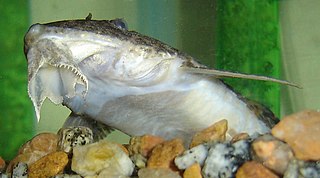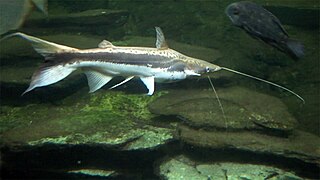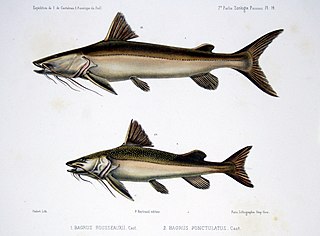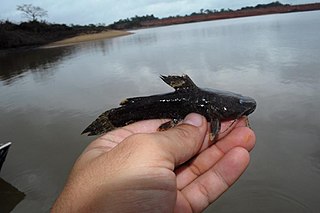
Callichthyidae is a family of catfishes, called armored catfishes due to the two rows of bony plates along the lengths of their bodies. It contains some of the most popular freshwater aquarium fish, such as many species in the genus Corydoras.

Callichthys callichthys, the cascarudo, armored catfish, bubblenest catfish, hassar, or mailed catfish, is a subtropical freshwater fish belonging to the subfamily Callichthyinae of the family Callichthyidae.

Rineloricaria is a genus of freshwater tropical catfish belonging to the family Loricariidae. They are commonly called whiptail catfish because of the long filament that grows out of the tip of the caudal fin that is characteristic of the genus. With the exception of R. altipinnis from Panama, they are native to the rivers of northern and central South America. Some species are regularly seen in the aquarium trade.

Parapterois is a genus of marine ray-finned fishes belonging to the family Scorpaenidae, the scorpionfishes. These fish originate from marine environments in the Indian Ocean or near it. The venomous Parapterois heterura is occasionally seen as an aquarium fish.

Sorubim is a small genus of long-whiskered catfish native to tropical South America. A number of characteristics allows the differentiation of each species in the genus. Sorubim species are important food fish in South America and are highly significant to fisheries of some areas; however, harvests of these fish are not identified as much as other, more popular food fishes such as Colossoma, Arapaima, and Brachyplatystoma. Some species of this family are popular aquarium fish.

Brachyplatystoma is a genus of catfish from the family Pimelodidae. As the occasionally used common name goliath catfishes indicates, this genus includes some of the largest species of catfish, including the piraíba, B. filamentosum, which reaches up to the region of 3.6 metres (12 ft) in length. Brachyplatystoma are found in the Amazon and Orinoco basins, and other tropical freshwater and brackish habitats in South America. Some species are migratory. These fish are important as food fish and, to some extent, aquarium fish.
Lepthoplosternum is a small genus of freshwater catfish in the Callichthyinae subfamily of the armored catfish family.

Batrochoglanis is a small genus of catfishes of the family Pseudopimelodidae.

Auchenipterichthys is a genus of driftwood catfishes found in South America.

Bagrichthys is a genus of bagrid catfishes.
Corumbataia is a genus of armored catfishes native to South America where they are only known from Brazil.

Bagarius is an Asian genus of catfishes of the family Sisoridae. It includes five to six extant species and potentially one extinct fossil species, B. gigas.

Sisor is a genus of catfishes native to Asia.
Breitensteinia is a genus of catfishes of the family Akysidae. It includes three species.

Paraplotosus is a genus of catfishes native to Australasia and South-east Asia.
The tenspine grouper is a species of marine ray-finned fish, a grouper from the subfamily Epinephelinae which is part of the family Serranidae, which also includes the anthias and sea basses. It is found along the western coast of Mexico and Central America, but is a very rare fish of which little information exists.

Entomocorus is a genus of catfishes of the family Auchenipteridae.
Entomocorus gameroi is a species of driftwood catfish native to Venezuela and questionably present in Colombia. It is found in the Apure River basin. It grows to a length of 7.0 cm and can be distinguished from its congeners by an oblique band crossing from the dorsal profile of the caudal peduncle to the middle-upper rays of the caudal fin. E. gameroi is classified as an omnivore with a tendency towards insectivory; it has been found to eat cladocerans, copepods, and water mites, as well as ostracods, insects including coleopterans, dipterans, ephemeropterans, hemipterans, and seeds and other vegetal matter.

Megalechis picta, the Tail bar armored catfish, Tail bar hoplo or Spotted Hoplo, is a species of catfish of the family Callichthyidae. M. picta occurs east of the Andes in the Amazon, Orinoco, and upper Essequibo River basins, and coastal rivers of northern Brazil.

Synodontis multimaculatus, known as the dotted synodontis, is a species of upside-down catfish that is native to the Democratic Republic of the Congo where it is found in the Ubangi River. It was first described by British-Belgian zoologist George Albert Boulenger in 1902, from a specimen collected in the Ubangi River in Mobayi-Mbongo, the Democratic Republic of the Congo. The species name multimaculatus is derived from the word multi, meaning many, and the Latin word maculatus, meaning spots, referring to the many spots on the fish.
















